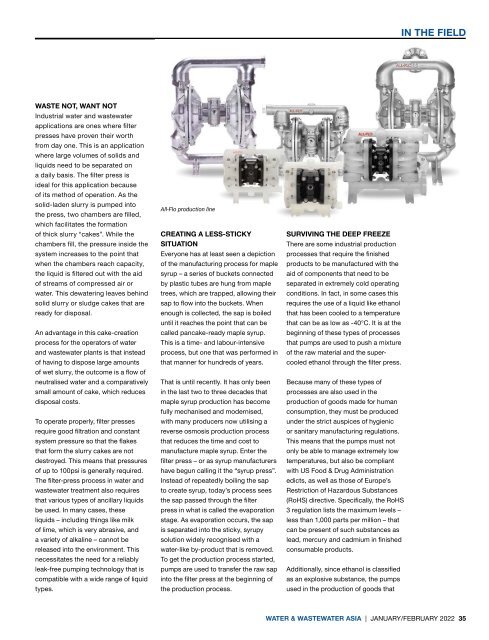Water & Wastewater Asia January/February 2022
Water & Wastewater Asia is an expert source of industry information, cementing its position as an indispensable tool for trade professionals in the water and wastewater industry. As the most reliable publication in the region, industry experts turn this premium journal for credible journalism and exclusive insight provided by fellow industry professionals. Water & Wastewater Asia incorporates the official newsletter of the Singapore Water Association (SWA).
Water & Wastewater Asia is an expert source of industry information, cementing its position as an indispensable tool for trade professionals in the water and wastewater industry. As the most reliable publication in the region, industry experts turn this premium journal for credible journalism and exclusive insight provided by fellow industry professionals. Water & Wastewater Asia incorporates the official newsletter of the Singapore Water Association (SWA).
You also want an ePaper? Increase the reach of your titles
YUMPU automatically turns print PDFs into web optimized ePapers that Google loves.
IN THE FIELD<br />
WASTE NOT, WANT NOT<br />
Industrial water and wastewater<br />
applications are ones where filter<br />
presses have proven their worth<br />
from day one. This is an application<br />
where large volumes of solids and<br />
liquids need to be separated on<br />
a daily basis. The filter press is<br />
ideal for this application because<br />
of its method of operation. As the<br />
solid-laden slurry is pumped into<br />
the press, two chambers are filled,<br />
which facilitates the formation<br />
of thick slurry “cakes”. While the<br />
chambers fill, the pressure inside the<br />
system increases to the point that<br />
when the chambers reach capacity,<br />
the liquid is filtered out with the aid<br />
of streams of compressed air or<br />
water. This dewatering leaves behind<br />
solid slurry or sludge cakes that are<br />
ready for disposal.<br />
An advantage in this cake-creation<br />
process for the operators of water<br />
and wastewater plants is that instead<br />
of having to dispose large amounts<br />
of wet slurry, the outcome is a flow of<br />
neutralised water and a comparatively<br />
small amount of cake, which reduces<br />
disposal costs.<br />
To operate properly, filter presses<br />
require good filtration and constant<br />
system pressure so that the flakes<br />
that form the slurry cakes are not<br />
destroyed. This means that pressures<br />
of up to 100psi is generally required.<br />
The filter-press process in water and<br />
wastewater treatment also requires<br />
that various types of ancillary liquids<br />
be used. In many cases, these<br />
liquids – including things like milk<br />
of lime, which is very abrasive, and<br />
a variety of alkaline – cannot be<br />
released into the environment. This<br />
necessitates the need for a reliably<br />
leak-free pumping technology that is<br />
compatible with a wide range of liquid<br />
types.<br />
All-Flo production line<br />
CREATING A LESS-STICKY<br />
SITUATION<br />
Everyone has at least seen a depiction<br />
of the manufacturing process for maple<br />
syrup – a series of buckets connected<br />
by plastic tubes are hung from maple<br />
trees, which are trapped, allowing their<br />
sap to flow into the buckets. When<br />
enough is collected, the sap is boiled<br />
until it reaches the point that can be<br />
called pancake-ready maple syrup.<br />
This is a time- and labour-intensive<br />
process, but one that was performed in<br />
that manner for hundreds of years.<br />
That is until recently. It has only been<br />
in the last two to three decades that<br />
maple syrup production has become<br />
fully mechanised and modernised,<br />
with many producers now utilising a<br />
reverse osmosis production process<br />
that reduces the time and cost to<br />
manufacture maple syrup. Enter the<br />
filter press – or as syrup manufacturers<br />
have begun calling it the “syrup press”.<br />
Instead of repeatedly boiling the sap<br />
to create syrup, today’s process sees<br />
the sap passed through the filter<br />
press in what is called the evaporation<br />
stage. As evaporation occurs, the sap<br />
is separated into the sticky, syrupy<br />
solution widely recognised with a<br />
water-like by-product that is removed.<br />
To get the production process started,<br />
pumps are used to transfer the raw sap<br />
into the filter press at the beginning of<br />
the production process.<br />
SURVIVING THE DEEP FREEZE<br />
There are some industrial production<br />
processes that require the finished<br />
products to be manufactured with the<br />
aid of components that need to be<br />
separated in extremely cold operating<br />
conditions. In fact, in some cases this<br />
requires the use of a liquid like ethanol<br />
that has been cooled to a temperature<br />
that can be as low as -40°C. It is at the<br />
beginning of these types of processes<br />
that pumps are used to push a mixture<br />
of the raw material and the supercooled<br />
ethanol through the filter press.<br />
Because many of these types of<br />
processes are also used in the<br />
production of goods made for human<br />
consumption, they must be produced<br />
under the strict auspices of hygienic<br />
or sanitary manufacturing regulations.<br />
This means that the pumps must not<br />
only be able to manage extremely low<br />
temperatures, but also be compliant<br />
with US Food & Drug Administration<br />
edicts, as well as those of Europe’s<br />
Restriction of Hazardous Substances<br />
(RoHS) directive. Specifically, the RoHS<br />
3 regulation lists the maximum levels –<br />
less than 1,000 parts per million – that<br />
can be present of such substances as<br />
lead, mercury and cadmium in finished<br />
consumable products.<br />
Additionally, since ethanol is classified<br />
as an explosive substance, the pumps<br />
used in the production of goods that<br />
WATER & WASTEWATER ASIA | JANUARY/FEBRUARY <strong>2022</strong> 35


















